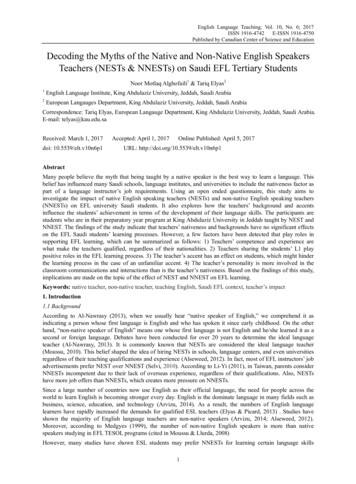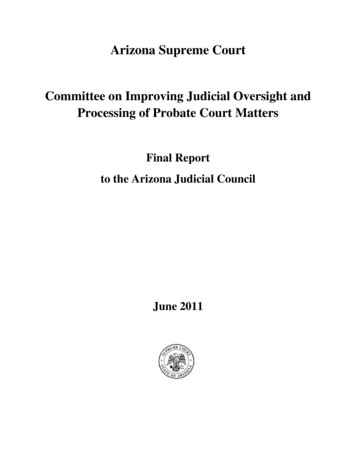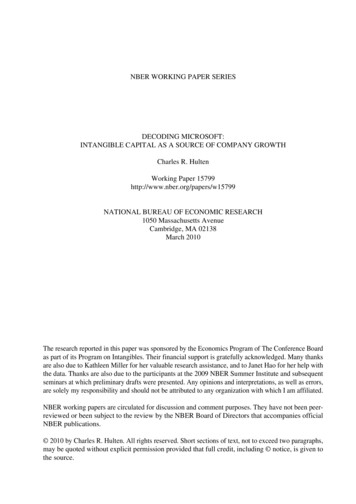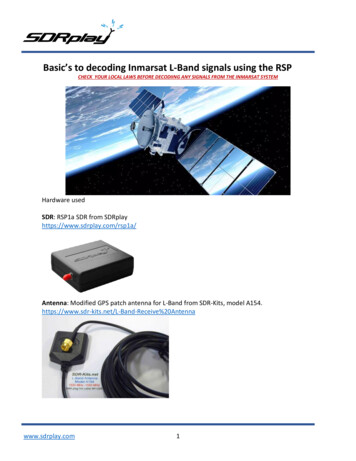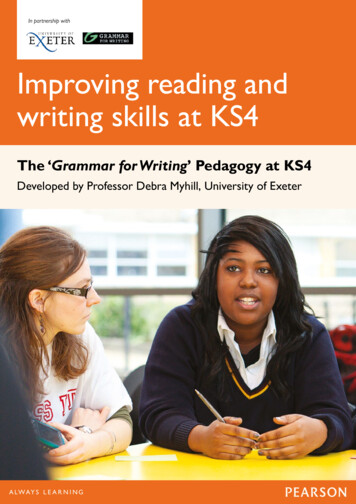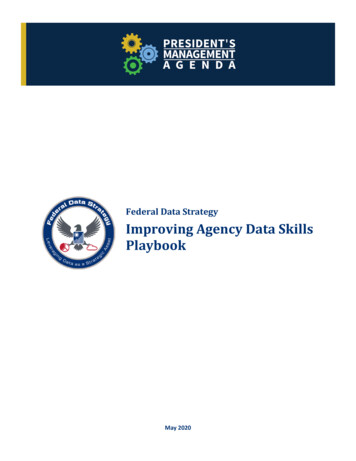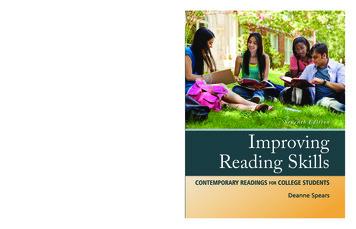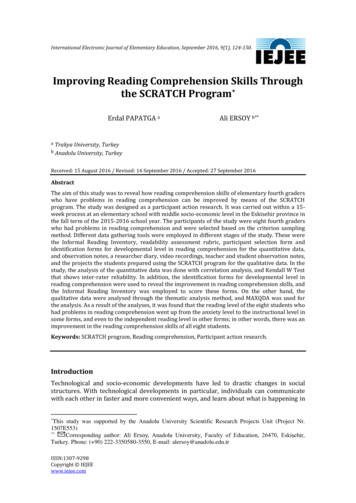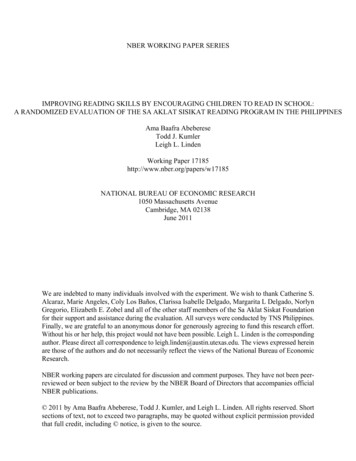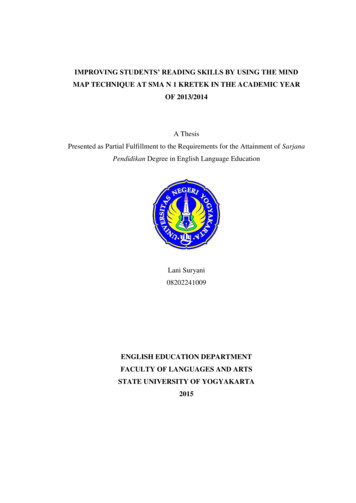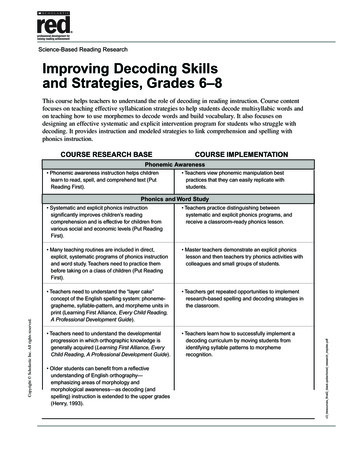
Transcription
Science-Based Reading ResearchImproving Decoding Skillsand Strategies, Grades 6–8This course helps teachers to understand the role of decoding in reading instruction. Course contentfocuses on teaching effective syllabication strategies to help students decode multisyllabic words andon teaching how to use morphemes to decode words and build vocabulary. It also focuses ondesigning an effective systematic and explicit intervention program for students who struggle withdecoding. It provides instruction and modeled strategies to link comprehension and spelling withphonics instruction.COURSE RESEARCH BASECOURSE IMPLEMENTATIONPhonemic Awareness Phonemic awareness instruction helps childrenlearn to read, spell, and comprehend text (PutReading First). Teachers view phonemic manipulation bestpractices that they can easily replicate withstudents. Teachers practice distinguishing betweensystematic and explicit phonics programs, andreceive a classroom-ready phonics lesson. Many teaching routines are included in direct,explicit, systematic programs of phonics instructionand word study. Teachers need to practice thembefore taking on a class of children (Put ReadingFirst). Master teachers demonstrate an explicit phonicslesson and then teachers try phonics activities withcolleagues and small groups of students. Teachers need to understand the “layer cake”concept of the English spelling system: phonemegrapheme, syllable-pattern, and morpheme units inprint (Learning First Alliance, Every Child Reading,A Professional Development Guide). Teachers get repeated opportunities to implementresearch-based spelling and decoding strategies inthe classroom. Teachers need to understand the developmentalprogression in which orthographic knowledge isgenerally acquired (Learning First Alliance, EveryChild Reading, A Professional Development Guide). Teachers learn how to successfully implement adecoding curriculum by moving students fromidentifying syllable patterns to morphemerecognition. Older students can benefit from a reflectiveunderstanding of English orthography—emphasizing areas of morphology andmorphological awareness—as decoding (andspelling) instruction is extended to the upper grades(Henry, 1993).c3 tresources final2 black.qxdschored research impdec.pdfCopyright Scholastic Inc. All rights reserved.Phonics and Word Study Systematic and explicit phonics instructionsignificantly improves children’s readingcomprehension and is effective for children fromvarious social and economic levels (Put ReadingFirst).
Science-Based Reading ResearchImproving Decoding Skills and Strategies,Grades 6-8, cont’dCOURSE RESEARCH BASECOURSE IMPLEMENTATIONPhonics and Word Study, cont’d “Systematic phonics instruction typically involvesexplicitly teaching students a pre-specified set ofletter-sound relationships and having studentspractice using these relations to decode words”(National Reading Panel, 2000). Teachers view a video demonstrating how toadminister a CORE phonics survey; they learn howthe results of this assessment can inform phonicsinstruction for 6th-8th-graders; they can downloadthe CORE phonics survey to administer to their ownstudentsFluency “Automatic word recognition, which is dependent onphonics knowledge, allows the reader to attend tomeaning; likewise, slow, belabored decodingoverloads short-memory and impedescomprehension” (Moats, 1998). Teachers examine struggling readers’ lack ofdecoding skills and learn how to help students beable to automatically recognize words throughcommon syllable and morpheme patterns. Development of efficient word recognition skill isassociated with improved comprehension (NationalReading Panel, 2000). Many students in upper grades will benefit fromcontinuing to learn specific strategies for decodingand spelling. Because a large number of words inthese students’ vocabularies derive from Latin andGreek origins, teaching frequently used Latin andGreek word roots and affixes enhances not onlydecoding and spelling ability, but vocabularydevelopment as well (Henry, 1993). Teachers view a video of a 7th-grade teacherproviding direct instruction on Latin roots; theyexplore classroom-ready lessons along with ageappropriate word lists on Latin and Greek word rootderivatives and receive direct online instruction onhow to use etymology in vocabulary instruction. Nagy and Anderson estimated that there are morethan 400,000 distinct words (excluding propernouns, numbers, and foreign words) in “printedschool English” (grades 3–9). Many of these words,however, are related semantically through theirmorphology (Nagy and Anderson, 1984). Modeled lesson plans and interactive activitiesprovide teachers with new strategies andtechniques to introduce meaning relationshipsamong words; online direct instruction explains theimportance of morphemes in both decoding anddetermining the meaning of an unknown word.schored research impdec.pdfCopyright Scholastic Inc. All rights reserved.VocabularyPage 2
Science-Based Reading ResearchImproving Decoding Skills and Strategies,Grades 6-8, cont’dCOURSE RESEARCH BASECOURSE IMPLEMENTATIONComprehension Facility with big words is essential for students asthey read, write, and learn in all areas of schooland life. Many big words occur infrequently, butwhen they do occur they carry a lot of the meaningand content of what is being read (Cunningham,1998). Heavy emphasis is placed on how to introducestrategies and techniques that will help studentsread and derive meaning from “big” words. As vocabulary and concept demands increase intext, children need to be able to devote more oftheir attention to making meaning from texts andincreasingly less attention to decoding. If childrenhave to devote too much time to decoding words,their reading will be slow and labored. This willresult in comprehension difficulties (Blevins, 2001). Repeated student practice with syllabication andmorpheme activities are supplied throughout toimprove individual decoding strategies, increaseautomaticity, and maximize comprehension. English orthography is a structured and predictablesystem in which spelling for phonemes, syllables,and morphemes are rule-governed or explainableaccording to a word’s historical origins, meaning,and sound structure (Moats, 1995). Direct online instruction explains the phonicsspelling relationship; sorting and simulationactivities prepare teachers to have studentsgenerate rules to explain different spelling patterns. Children progress through a number of stages asthey become fluent spellers. The final stage iscalled derivational constancy. This is the stage atwhich children notice the sophisticated patternsrepresented by the spelling of multisyllabic wordsand also the stage in which morphology plays adominant role (Zutell, 1998). Classroom word-sorting activities help studentslearn to group words by common spelling patterns. Word-sorting categorization or word-sort activitiesare one of the most effective ways to guidestudents toward spelling generalizations andtoward understanding more generally how thespelling system works (Templeton, 2002.schored research impdec.pdfCopyright Scholastic Inc. All rights reserved.SpellingPage 3
Science-Based Reading ResearchImproving Decoding Skills and Strategies,Grades 6-8, cont’dCOURSE RESEARCH BASECOURSE IMPLEMENTATIONSyllabication Once a reader perceives a syllable, he beginssearching the memory for a word that matchesthose letters, simultaneously beginning to soundout the letter combinations (Hall and Moats, 1999). Direct online instruction, syllabication simulations,sorting activities, effective syllabication modeling,and lesson plans provide teachers with the propertools for grade-appropriate syllable patterninstruction on all syllable types. When students attempt to read polysyllabic words,those who know how to use rules for syllabledivision exhibit strategies beyond letter-soundcorrespondences for word analysis. Those whorecognize meaningful morpheme pattersincorporate still another strategy (Henry, 1993). When intermediate students were shown how touse vowels and affixes to pronounce multisyllabicwords and then practiced decoding words afteridentifying these parts, the students laterdemonstrated significantly greater ability topronounce multisyllabic words that had not beenincluded in their practice. (Shefelbine, 1990) Through direct online instruction, teachers learn atechnique for teaching how to decode multisyllabicwords containing both closed and open syllables;teachers observe model lessons onhow studentscan use vowels and affixes to easily pronouncemultisyllabic words. Being able to divide a word into syllables may helpstudents figure out a word without reading all of it(Henry, 1990). Teachers find out how to use small and independentsyllabication activities such as speed drills; they areprovided with video modeling, activities and lessonsfor teaching syllabication in a whole-class settingschored research impdec.pdfCopyright Scholastic Inc. All rights reserved. Skillful readers’ ability to read long words dependson their ability to break the words into syllables.This is true for familiar and unfamiliar words(Adams, 1990).Page 4
Science-Based Reading ResearchImproving Decoding Skills and Strategies,Grades 6-8, cont’dCOURSE RESEARCH BASECOURSE IMPLEMENTATIONMorphology (Prefixes and Suffixes) If students receive direct instruction in themeanings of the most commonly used prefixes, theremoval of the most common suffixes, and thespelling changes associated with the additions ofinflections beginning with vowels, they cansuccessfully analyze 250 new printed words peryear through morphological analysis (White, Power,and White, 1989). Teachers get an opportunity to hear a reader whostruggles with suffixes and select the best strategyto help her; prefix and suffix simulations usinggrade-appropriate words, expert modeling, detailedlessons, and supplied lists of the most commonprefixes and suffixes provide teachers with a strongword-meaning learning environment base. Much of the vocabulary explosion that beginsaround 4th grade is due to words with a prefix,suffix, or both (Nagy and Anderson, 1984). It has been found that 97 percent of prefixed wordsin printed school English are derived from twentycommon prefixes (White, Sowell and Yanagihara,1989). When students are decoding unknown multisyllabicwords, it is to their advantage to know prefixes andsuffixes. Such knowledge will also help in learningthe meaning of a word (Chall and Popp, 1996).Morphology (Latin and Greek Roots) Becoming familiar with Latin and Greek roots withcommon affixes lays the groundwork forunderstanding key concepts in a number ofdifferent content areas, particularly science andsocial studies (Bear et al.,1996). Teachers find out how to teach the most commonLatin and Greek roots; Red provides lessons andcommon prefix and suffix lists to assist students inrecognizing word root patterns.schored research impdec.pdfCopyright Scholastic Inc. All rights reserved. About 60 percent of the words in English text are ofLatin and Greek origin (Henry, 1997).Page 5
Science-Based Reading ResearchImproving Decoding Skills and Strategies,Grades 6-8, cont’dReferencesBear, D.R., M. Invernizzi, S. Templeton, and E.F.Johnston. Words Their Way: Word Study for Phonics,Vocabulary, and Spelling Instruction. Upper SaddleRiver, NJ: Prentice-Hall, 1996.Henry, M. “Morphological Structure: Latin andGreek Roots and Affixes as Upper Grade CodeStrategies.” Reading and Writing: AnInterdisciplinary Journal, 1993.Beck, I., and C. Juel. “The Role of Decoding inLearning to Read.” American Educator’ (Summer1995).Moats, L.C. Spelling: Development, Disability andInstruction. York Press, 1995.Chall, J.S., and H.M. Popp. Teaching and AssessingPhonics: A Guide for Teachers. Educators PublishingService, 1996.Cunningham, P.M. “The Multisyllabic WordDilemma: Helping Students Build Meaning, Spelland Read ‘Big’ Words.” Reading and WritingQuarterly, 1998.Foorman, B. “Why Direct Spelling Instruction isImportant.” Scholastic Spelling: Research Paper.New York, 1997.Copyright Scholastic Inc. All rights reserved.Hall, S.L., and L.C. Moats . Straight Talk AboutReading: How Parents Can Make a DifferenceDuring the Early Years. NTC ContemporaryPublishing, 1999.Nagy, W.E., and R.C. Anderson. “How Many WordsAre There in Printed School English?” ReadingResearch Quarterly, 1984.Shefelbine, J. “A Syllable-Unit Approach to TeachingDecoding of Polysyllabic Words to Fourth- andSixth-Grade Disabled Readers.” In J. Zutell and S.McCormick (eds.), Literacy Theory and Research:Analysis from Multiple Paradigms. National ReadingConference, 1990.Zutell, J. “Word Sorting: A Developmental SpellingApproach to Word Study for Delayed Readers.”Reading and Writing Quarterly, 1998.schored research impdec.pdfChall, J.S. Stages of Reading Development. NewYork: MacGraw-Hill, 1983.National Reading Panel. Teaching Children to Read:An Evidence-Based Assessment of the ScientificResearch Literature on Reading and Its Implicationsfor Reading Instruction. Washington, DC: NationalInstitute of Child Health and Human Development,2000.Page 6
Improving Decoding Skills and Strategies, Grades 6-8,cont’d COURSE RESEARCH BASE “Systematic phonics instruction typically inv
